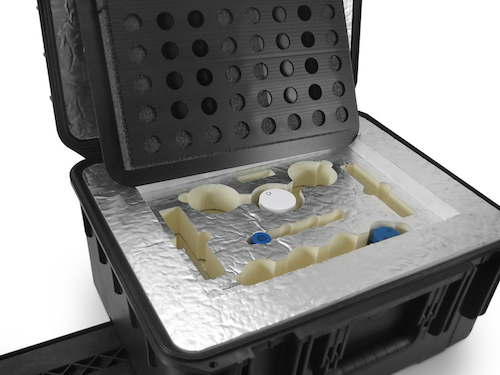When it comes to temperature-sensitive shipping, fast service and an eye-catching case aren’t enough. Perishable foods, bottled beverages, pharmaceuticals and a host of other sensitive goods require packaging solutions that keep contents within a strict temperature range. Too hot or too cold, and these products could become inedible, ineffective or even harmful to the people who consume them.
Fortunately, there are several effective methods for temperature-sensitive shipping, any of which can be incorporated into a customized, branded package.
Types of Temperature-Controlled Packaging
The logistics system that maintains optimal shipping conditions is often referred to as the “cold chain,” and one of its most important components is temperature-controlled packaging, or TCP. Within the realm of TCP, there are two main types of solutions: active and passive.
Active TCP systems include refrigerated containers, which require a battery or other power source to maintain their internal temperatures. While extremely effective, active TCP is by far the most expensive way to maintain temperatures, and it comes with a host of logistical hassles such as power outages and battery replacements.
In contrast, passive TCP relies on a combination of insulated packaging and refrigerants such as ice, gel packs, foam or liquid nitrogen. Accounting for all components, most passive TCP solutions include an outer carton, inner cooling area, refrigerant, individual item containers, protective packaging and, where required, leak-proof bags and absorbents. For most goods, passive systems are far more practical, versatile and cost-effective.
Materials Used in Temperature-Sensitive Shipping
The selection of specific materials for a passive TCP solution depends heavily upon the product being shipped. What are its dimensions? Does it involve bottles, vials or other breakable containers? What temperature range must be maintained — and for how long?
Just as important, manufacturers must consider transit conditions. Depending upon sea, air or land shipping, they may have to contend with vibration, electrical discharge and major fluctuations in ambient temperature. For instance, temperatures quickly rise on a summer tarmac, but in the air, the cargo containers on a plane drop to well below freezing.
Once these questions are answered, it becomes possible to select specific materials within a few different categories. For insulation, shippers may opt for a low-cost lightweight foam such as polystyrene or polyurethane, or a more compact vacuum-insulated panel. The former costs less to produce, but the latter offers greater temperature regulation and lower freight costs.
As for refrigerants, the most common options include dry ice, gel packs and phase-change materials (PCMs). Dry ice is cheap and effective, but it requires special handling as a hazardous material. Gel packs are reusable and rugged, but they may not retain their shape. While pricier, PCMs are sophisticated materials designed to change between solid, liquid and gas and provide the best temperature control.
Balancing the Variables of Temperature-Controlled Transport
Given all of these options and trade-offs, there may be a wide variety of acceptable TCP solutions for any given product. Selecting one is a matter of priorities.
On the one hand, you might want to maximize your payloads with dense, highly efficient packaging. That will reduce shipping costs, but the packaging itself will likely be more expensive. On the other hand, you might opt for a more lightweight, reusable system that adequately insulates the products you’re shipping and carries minimal environmental impact.
Also at play are complexity, the use of hazardous materials, transit route regulations and perhaps even limits on the total weight or volume of your packages. If your products are fragile as well as temperature-sensitive, then you’ll also need to take the durability of the packaging into account just as much as its insulation.
With so many variables to consider, it can be difficult to know which temperature-controlled shipping option is right for you. As your partner, Cases By Source can help find that answer and create a custom solution that preserves the quality and safety of your product in transit. To get the conversation started around your packaging solutions, contact us for a free consultation.








Leave a Comment